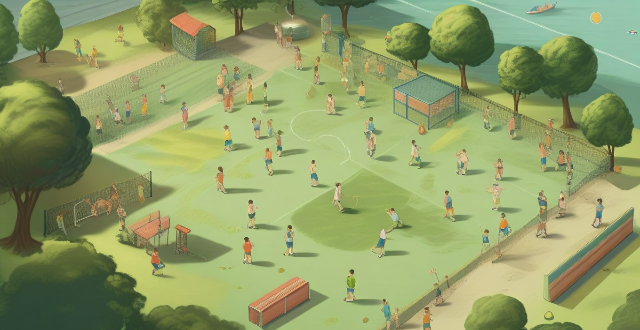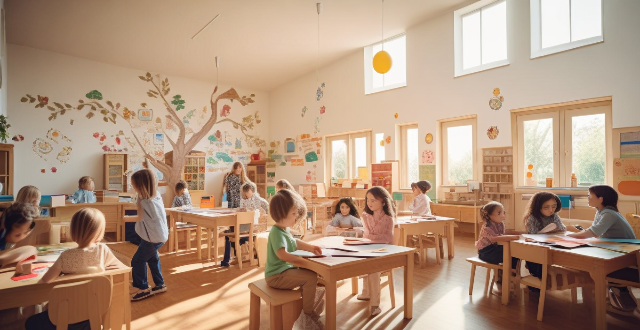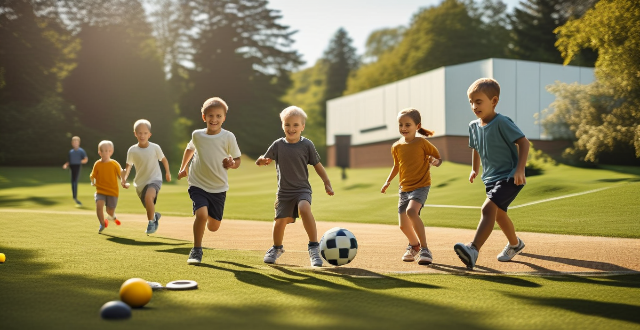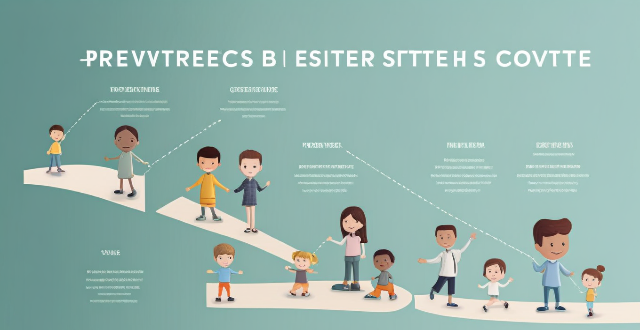Start Child

At what age should children start attending preschool ?
The appropriate age to start preschool varies depending on the individual child and their readiness for the experience. Most experts agree that three to four years old is an ideal age range for starting preschool. However, it's essential to consider each child's unique circumstances and needs before making a decision. Early education plays a crucial role in shaping a child's cognitive, social, and emotional development. By enrolling children in preschool, parents can help them develop essential skills such as socialization, language development, cognitive growth, and emotional intelligence. Before deciding when to start your child in preschool, consider factors such as the child's maturity level, developmental milestones, family situation, financial considerations, and quality of program.

How to choose the right extracurricular activity for your child ?
Choosing the right extracurricular activity for your child is crucial for their development and well-being. Consider your child's interests, skills, and abilities, evaluate the time commitment and logistics, seek recommendations and read reviews, and involve your child in the decision-making process to help them choose an activity they will enjoy and benefit from.

How do you identify a child who may have special education needs ?
Identifying a child with special education needs is crucial for providing them with the right support and interventions. Signs include delayed developmental milestones, difficulty in school, unusual behaviors or habits, and health concerns. If you suspect a child may have special education needs, consult with professionals to determine the appropriate course of action.

How can I teach my child better concentration habits ?
Concentration is an essential skill for children to develop as it helps them focus on tasks, learn new things, and achieve their goals. Teaching your child better concentration habits can be challenging, but with patience and consistency, you can help them improve their ability to pay attention and stay focused. Here are some tips to teach your child better concentration habits: 1\. Set Clear Expectations: Establish clear expectations for your child's behavior and concentration levels. Make sure they understand what is expected of them and why it is important. 2\. Create a Distraction-Free Environment: Minimize distractions in your child's environment to help them concentrate better. Turn off the TV, put away toys or electronic devices, and ensure that there are no loud noises or interruptions during study or task time. 3\. Break Tasks into Smaller Chunks: Breaking down tasks into smaller, more manageable chunks can help your child stay focused and avoid feeling overwhelmed. 4\. Use Visual Cues: Visual cues such as checklists or charts can help your child stay organized and focused on their tasks. 5\. Encourage Short Breaks: Encourage your child to take short breaks between tasks to recharge their mental batteries. A five-minute break every hour or so can help them maintain focus and avoid burnout. 6\. Practice Mindfulness Techniques: Mindfulness techniques such as deep breathing exercises or meditation can help your child develop better concentration habits. 7\. Praise Effort and Progress: Praising your child's effort and progress can motivate them to continue working towards better concentration habits. Acknowledge their accomplishments and encourage them to keep pushing themselves to improve.

What are the key elements of child safety education ?
Child safety education is crucial for the well-being and protection of children. It involves teaching children about potential dangers and how to avoid them. This educational process helps children develop a sense of awareness, responsibility, and self-protection. In this article, we will discuss the key elements of child safety education. The main elements of child safety education include personal safety, stranger danger, internet safety, home safety, school safety, and road safety. Personal safety includes teaching children about personal boundaries, private parts, and inappropriate behaviors. Stranger danger education helps children identify potential threats from unknown individuals. Internet safety education is essential in today's digital age. Home safety education focuses on creating a safe environment for children at home. School safety education aims to create a safe learning environment for children. Road safety education is crucial for children who walk or cycle to school or play outside. By focusing on these key elements of child safety education, we can help children develop the skills and knowledge they need to stay safe and protect themselves from potential dangers. Child safety education is an ongoing process that requires the involvement of parents, schools, communities, and governments.

How do family courts handle cases related to domestic violence and child custody ?
Family courts play a crucial role in handling cases related to domestic violence and child custody, prioritizing safety, investigating allegations, considering the best interests of the child, making custody decisions, and providing ongoing support and monitoring.

What is the relationship between physical literacy and child development ?
Physical literacy is crucial for child development, enhancing cognitive, social, emotional, and physical dimensions of learning. It improves memory, attention, problem-solving skills, communication, cooperation, empathy, self-esteem, resilience, muscle strength, cardiovascular health, and reduces the risk of chronic diseases. Incorporating regular physical activity into children's daily routines promotes their overall growth and well-being.

What are some creative ways to spend quality time with your child without using technology ?
Spending quality time with your child is crucial for their development and well-being. Here are some creative ways to do so without relying on technology: 1. Outdoor Adventures: Take nature walks or plan camping trips to explore the outdoors together. 2. Creative Activities: Encourage art projects and music making to foster creativity in your child. 3. Educational Games: Play board games that require critical thinking and work on puzzles together to improve cognitive abilities. 4. Physical Activities: Engage in sports or introduce yoga and meditation practices for physical and mental well-being. 5. Reading Together: Have storytime sessions and visit libraries regularly to foster a love for reading and learning.

Can I get sports insurance for my child who plays school sports ?
Sports insurance can provide coverage for athletes participating in organized sports, including school sports. Consider factors like age limit, type of sports, level of competition, and coverage details when selecting a policy. Cost, duration, additional benefits, and the application process are also important considerations. While sports insurance offers peace of mind and financial protection, it can be expensive and may have limitations. Evaluate your child's needs and consult with an insurance professional to make an informed decision.

How do I start saving for retirement ?
Saving for retirement is a crucial aspect of financial planning. Here are some steps to start saving for your retirement: 1. Set a retirement goal based on factors like age, income, and expenses. 2. Create a budget that accounts for monthly expenses and income. 3. Start saving early to take advantage of compound interest. 4. Contribute regularly to a retirement account through automatic deposits. 5. Consider tax-advantaged accounts like 401(k)s and IRAs for tax benefits. 6. Invest wisely by diversifying your portfolio with stocks, bonds, and other assets. 7. Review your retirement plan regularly to stay on track and make adjustments as needed.

What measures should be taken to protect the rights of child laborers who work in industries affected by climate change ?
Protecting the rights of child laborers in industries affected by climate change requires a multifaceted approach that involves legislative actions, education and awareness, economic support, access to education, health and safety measures, and international cooperation. Ensuring that existing labor laws are enforced and amending legal frameworks to include specific provisions for protecting child laborers is crucial. Educating communities about the dangers of child labor and raising awareness among parents and communities about the importance of education can help reduce the reliance on child labor. Providing financial aid to families and creating alternative income sources can also reduce their dependence on child labor income. Improving access to education by building schools in rural areas and offering flexible schooling options can help accommodate children who need to work. Providing healthcare services and implementing safety measures in workplaces where child laborers are employed is essential. Collaborating with international organizations and sharing best practices can help address the issue of child labor globally. By implementing these measures, we can ensure that child laborers are protected and empowered to build a better future for themselves and their communities.

How do individual versus team sports differ in their impact on child development ?
Individual sports foster self-reliance and technical mastery, while team sports emphasize social skills and emotional intelligence. Both have unique benefits for child development, and the choice should consider the child's personality and desired skill development. A combination of both might provide the most well-rounded experience.

At what age can children start participating in organized sports ?
Participating in organized sports can be a beneficial experience for children, providing them with opportunities to develop physical skills, socialize with peers, and learn important values such as teamwork and perseverance. However, it is important to consider the appropriate age at which children should start participating in organized sports. Some factors to consider when determining the right age for children to begin participating in organized sports include developmental readiness, socialization and peer interaction, and parental involvement and support. It is essential to ensure that the child has reached a level of physical, cognitive, and emotional maturity that will allow them to benefit from and enjoy the experience. Additionally, it is crucial to ensure that the child is emotionally ready to interact with peers and handle the social dynamics of a team sport. Parental involvement and support are also critical factors to consider when determining if a child is ready to participate in organized sports. By taking these factors into account and ensuring that the child is ready and eager to participate, parents can help set their child up for a positive and rewarding experience in organized sports.

What resources are available for women looking to start their own business ?
Starting a business can be challenging, but women can turn their entrepreneurial dreams into reality with the right resources and support. Government programs and grants, non-profit organizations and foundations, online platforms and networks, and educational resources are all available to help women start their own businesses. These resources provide funding opportunities, training programs, networking events, specialized programs for minority and immigrant women, counseling and mentorship opportunities, access to free resources and workshops, and more. By utilizing these resources, women can gain the knowledge, skills, and support needed to successfully start and grow their own businesses.

How can parents encourage their children to be more active ?
Parents play a significant role in encouraging their children to be more active. Here are some ways to do so: 1. Set an example by being active and engaging in physical activities regularly. 2. Create a supportive environment by providing access to sports equipment and encouraging outdoor play. 3. Make physical activity fun by finding activities that your child enjoys and using games and challenges. 4. Help your child set realistic goals for their physical activity and celebrate achievements along the way. 5. Limit screen time and encourage alternative activities instead. 6. Involve your child in household chores such as cleaning, gardening, or cooking to build strength, coordination, and endurance while teaching responsibility and teamwork.

How can parents incorporate physical activity into their homeschooling routine ?
Incorporating physical activity into a homeschooling routine is crucial for a child's development, as it enhances cognitive abilities, improves mood, and fosters social skills. Parents can achieve this by scheduling regular exercise time, integrating movement into learning, involving outdoor activities, making physical activity fun, setting an example, and using technology. Starting the day with exercise, taking breaks for physical activity, teaching concepts through movement, combining art with movement, planning nature walks or hikes, assigning gardening tasks or outdoor chores, playing games, hosting dance parties, participating in physical activities alongside the child, enrolling the child in online fitness classes or following workout videos, and allowing the child to play active video games are some effective ways to incorporate physical activity into the homeschooling routine.

What are some fast strategies for organizing my child's toys and books ?
Fast Strategies for Organizing Your Child's Toys and Books: 1. Create a storage system using labeled bins, shelves, and hanging organizers. 2. Implement a cleaning routine with daily tidy-up time and weekly deep cleans. 3. Rotate toys and books seasonally or based on age appropriateness. 4. Involve your child in the process by making it fun and allowing choices. 5. Utilize multipurpose furniture with built-in storage for added organization.

How do I set up parental controls on my child's Apple device ?
The text provides a step-by-step guide on how to set up parental controls on an Apple device for children. The steps include creating a family group, turning on Screen Time, setting up content and privacy restrictions, establishing downtime and app limits, and monitoring the child's device usage. The purpose of these steps is to ensure the child's safety and well-being while using technology by controlling what apps, websites, and features they can access, as well as when and how much they can use their device.

What is the ideal age for a woman to start trying for a baby ?
The ideal age for women to start trying for a baby varies depending on individual circumstances, but generally, women in their late 20s and early 30s are considered to be in the optimal age range due to their physical health, emotional readiness, and financial stability.

How do you handle disagreements with your child over homeschooling ?
Handling disagreements with your child over homeschooling requires listening actively, validating their feelings, discussing issues collaboratively, seeking professional advice when needed, and maintaining open communication.

What are the benefits of participating in parent-child activities together ?
Participating in parent-child activities together offers numerous benefits, including improved communication, stronger emotional connections, physical health benefits, cognitive development, social skills development, and the creation of lifelong memories. By engaging in these activities, families can strengthen their relationships, improve communication, and create lasting memories that will be cherished for years to come.

How do you handle discipline in a homeschooling environment ?
Handling discipline in a homeschooling environment is crucial for ensuring an efficient and effective learning process. Here are some tips: 1. Set clear expectations at the beginning of each school year, outlining rules and consequences for breaking them. 2. Consistency is key when enforcing rules and consequences to help your child understand that their actions have consequences. 3. Use positive reinforcement to encourage good behavior and academic success, such as praise or small rewards for achieving specific goals. 4. Be a role model by leading with patience, understanding, and respect when addressing your child's misbehavior. 5. Encourage open communication with your child about the rules and consequences in place, being open to feedback and suggestions from them.

How can I teach my child to better understand what they read ?
Teaching your child to better understand what they read involves encouraging active reading, using visual aids, discussing the text with them, and practicing regularly.

How do I choose the right preschool for my child ?
Choosing a preschool involves considering factors like philosophy, teacher qualifications, curriculum, and communication. It's important to visit potential schools and talk to other parents before deciding which one is best for your child.

Is it safe to start a new exercise program during pregnancy ?
Is it safe to start a new exercise program during pregnancy? This article explores the topic, highlighting health benefits and potential risks. It emphasizes consulting with healthcare providers, choosing appropriate exercises, and monitoring body responses for safety.

How can technology be used to enhance child safety education ?
Technology can significantly enhance child safety education through various strategies such as interactive learning applications, virtual reality experiences, online safety courses, wearable devices, and social media engagement. These tools not only make learning fun and engaging but also provide practical, real-world simulations that help children develop essential safety skills. By utilizing these modern methods, we can equip the younger generation with the knowledge and confidence needed to stay safe in a rapidly changing world.

How can I make sure my child is getting a healthy, balanced diet ?
Ensuring a healthy, balanced diet for your child involves offering a variety of foods, limiting junk food and sugary beverages, planning meals, practicing portion control, and being a role model.